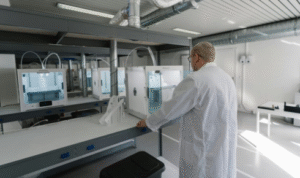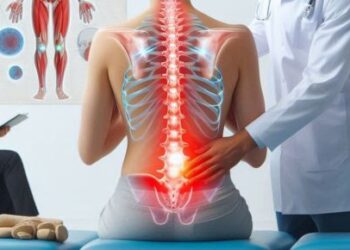
Ergonomic workstations have become a common strategy for managing discomfort at desks, especially among remote workers and older adults aiming to preserve spinal health. Adjustable chairs, standing desks, lumbar cushions and monitor risers all play an important role in maintaining posture and reducing repetitive strain. Dr. Larry Davidson, a leader in spinal surgery, recognizes that while ergonomic tools help minimize positional stress, they are not a substitute for clinical evaluation when symptoms suggest underlying spinal issues. Understanding the boundaries of self-management is key to preventing minor aches from becoming long-term spinal conditions.
Even the most carefully designed workspace can only go so far. When discomfort persists or begins to interfere with daily function, it may indicate the need for further evaluation. Identifying the right moment to transition from at-home solutions to professional assessment is often the difference between early intervention and delayed care.
The Value and Limits of Ergonomic Adjustments
A proper ergonomic setup aligns the head, neck, spine and limbs to reduce stress during prolonged sitting or standing. These modifications are effective for relieving muscle tension and redistributing pressure during low-impact work activities.
Ergonomic adjustments can be especially effective in easing symptoms caused by overuse or poor posture. For example, elevating a monitor can ease cervical strain, while lumbar supports encourage the spine’s natural curve. But they don’t address deeper structural issues that can present similarly, such as disc degeneration, spinal narrowing or nerve compression.
The common mistake is assuming that improved posture or equipment alone can resolve pain that stems from internal changes. Prolonged reliance on these fixes, without clinical assessment, can mask progressive conditions that require medical attention.
When Symptoms Point Beyond the Chair
Certain signs suggest it’s time to move beyond workspace modification. These include:
- Pain that persists or worsens despite ergonomic correction
- Tingling, numbness, or weakness in the limbs
- Radiating discomfort from the neck into the arms or from the lower back into the legs
- Changes in coordination, gait, or grip strength
- Discomfort that disrupts sleep or daily function
These indicators often point to nerve involvement or structural degeneration, both of which benefit from early detection. Ergonomic adjustments may continue to support comfort, but they cannot resolve pressure on nerve roots or loss of disc height.
Imaging such as MRI or CT scans may be needed to confirm or rule out the presence of disc herniation, spinal stenosis or spondylolisthesis. Waiting too long to pursue imaging can lead to more aggressive interventions later.
Understanding Referred Pain and Diagnostic Confusion
One of the challenges in spinal care is the overlap between muscular and neurological pain. Referred pain patterns can create sensations in the shoulder, arm, hip or leg even when the primary source is spinal. For example, a compressed nerve in the lower back may cause tingling in the foot, while a cervical disc issue could present as hand numbness.
This overlap often leads individuals to treat the symptom, rather than the cause. Stretching, changing chairs or improving workstation height may bring temporary relief, but does not address the nerve signal disruption triggering the pain.
Dr. Larry Davidson emphasizes the importance of clinical input, when ergonomic interventions don’t consistently improve. Primary care providers, physical therapists or spine specialists can evaluate symptom patterns, perform functional tests and recommend appropriate imaging, when warranted.
When to Involve a Medical Professional
There is no need to wait for severe symptoms to consult a provider. Early intervention often leads to more conservative treatment options and faster recovery. It’s appropriate to seek medical evaluation when:
- Pain persists for more than two weeks despite environmental changes
- Symptoms begin to affect other parts of the body or interfere with mobility
- Pain intensity increases or becomes unpredictable
- Daily functions like dressing, walking, or sleeping become difficult
During an evaluation, clinicians may assess posture, strength, nerve reflexes and range of motion. These tests help determine whether symptoms stem from mechanical strain or involve the nervous system. Imaging as a Diagnostic Tool, not a First Step
Not every case of spinal discomfort requires imaging. But when conservative efforts like ergonomics, exercise and rest fail to bring relief, scans can offer valuable insights.
MRI is often the preferred method for evaluating disc health, nerve compression and soft tissue conditions. CT scans may be used for bone structure assessments. These tools allow providers to plan care pathways that align with the severity and nature of the condition.
Still, imaging is only part of the process. Clinical judgment and physical evaluation remain central to making informed decisions about treatment. The goal is to find the right balance between supportive self-care and medical management.
What to Continue While You Wait
While waiting for an appointment or imaging referral, patients can still benefit from gentle movement, hydration and good postural habits. But it’s important to avoid activities that aggravate symptoms, such as prolonged sitting, repetitive bending or heavy lifting.
Supportive gear like lumbar cushions or wrist pads can still reduce secondary strain. But once symptoms suggest something more complex, these tools should be viewed as comfort aids, not treatment solutions.
Looking Beyond the Workspace
Spinal health involves more than just furniture and accessories. Diet, physical activity, core strength and age-related changes all affect spine behavior. For some individuals, chronic inflammation, previous injury or conditions like arthritis may limit the effectiveness of ergonomic fixes.
When symptoms arise despite ideal setups, it’s often a sign that the spine needs more focused attention. It doesn’t always mean surgery. Physical therapy, targeted stretching, manual therapy or injections may offer relief before more invasive options are considered.
Early recognition and action help seniors avoid long-term damage and maintain independence.
Knowing When Change Isn’t Enough
Even the most well-designed workspace can’t fix deeper anatomical problems. Knowing when your body needs more than just ergonomic tools is an important part of long-term self-care.
Getting involved with a medical provider can shift the focus from reactive pain management to proactive spinal health. When addressed early, even age-related changes can be managed with conservative, supportive strategies that extend quality of life.











